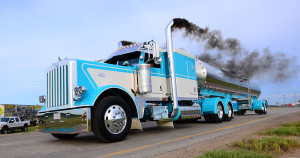 We all have an opinion about CARB (California Air Resources Board) and their stringent, if not ridiculous, regulations. But, no matter how we feel, the regulations are here and they are here to stay. This month, in the midst of all the compliance confusion, I am going to try my best to help the drivers who are not sure of what they need to do and when they have to do it. But, bear with me, because this stuff can get confusing!
We all have an opinion about CARB (California Air Resources Board) and their stringent, if not ridiculous, regulations. But, no matter how we feel, the regulations are here and they are here to stay. This month, in the midst of all the compliance confusion, I am going to try my best to help the drivers who are not sure of what they need to do and when they have to do it. But, bear with me, because this stuff can get confusing!
Remember, although California might be leading the charge on some fronts, they are not alone. The Federal Government has made many mandates regarding the new truck standards and the EPA chimes in with their silly ideas and regulations about trucks, as well. Many might say, “Screw California, I just won’t go there anymore,” but the truth is, several other states will be following in California’s footsteps soon, so you might as well figure out what you are going to do now – or at least start thinking about it, because one day in the not-so-distant future, we will ALL have to deal with this stuff, no matter where we live and/or run.
It was 12/12/08 when CARB approved the truck and bus regulation to significantly reduce particulate matter (PM) and oxides of nitrogen emissions from existing diesel vehicles operating in California. In a nutshell, CARB mandated that all existing diesel engines be either retrofitted with a Diesel Particulate Filter (DPF) or replaced by a 2010 or newer engine by certain dates, depending on several factors including fleet size, engine model year (not truck model year), vehicle weight and mode of operation.
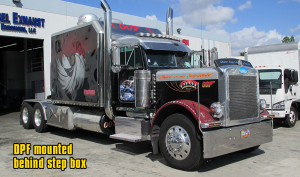 Compliance is broken down into two weight classes of trucks – those that are 14,001-26,000 GVWR, and those that are heavier than 26,000 GVWR. In regards to fleet size, in general, 1-3 trucks is considered to be a small fleet, while four or more trucks is considered to be a large fleet.
Compliance is broken down into two weight classes of trucks – those that are 14,001-26,000 GVWR, and those that are heavier than 26,000 GVWR. In regards to fleet size, in general, 1-3 trucks is considered to be a small fleet, while four or more trucks is considered to be a large fleet.
Schedules are in place that detail what year you have to retrofit your older engine with a DPF and/or when you need to replace the engine altogether. By the year 2023, every truck will need to have a 2010 or newer model engine, even if they retrofitted with a DPF at some point. Basically, the DPF buys you some time. And remember, the year of the engine is not necessarily the same as the year of the truck it is in.
Trucks 14,001-26,000 GVWR follow a fairly straight-forward replacement schedule, and they have no DPF requirements. In this group, large and small fleets follow the same schedule: 1995 & older engines needed to be replaced with a 2010 or newer engine by 1/1/15; 1996 replaced by 1/1/16; 1997 by 1/1/17; 1998 by 1/1/18; 1999 by 1/1/19; 2000-2003 by 1/1/20; 2004-2006 by 1/1/21; and 2007-2009 by 1/1/23.
The heavier category of trucks (over 26,000 GVWR) is where things start to differ for the small and large fleets. In regards to small fleets, CARB recently amended their schedule to give small fleets that brought at least one heavy truck into compliance by 1/1/14 more time. Fleets that did this can delay the requirements of their second truck to 1/1/17 and their third truck to 1/1/18. If this was not done by 1/1/14 it is too late and this option is no longer available. The trucks are now considered past due and must be brought into compliance immediately.
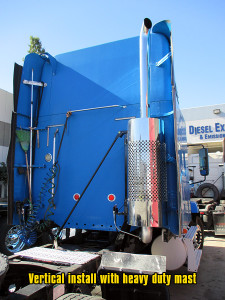 Large fleets were originally offered two options – Best Available Control Technology (BACT) or Phase-In. The BACT schedule is nothing more than an easy-to-follow engine model year schedule. The schedule had large fleets install DPFs on 1996-2006 engines during a period from 2012-2014. Following the retrofit period, retirement of all 1995 and older model engines was required.
Large fleets were originally offered two options – Best Available Control Technology (BACT) or Phase-In. The BACT schedule is nothing more than an easy-to-follow engine model year schedule. The schedule had large fleets install DPFs on 1996-2006 engines during a period from 2012-2014. Following the retrofit period, retirement of all 1995 and older model engines was required.
Here is the BACT schedule for large fleets over 26,000 GVWR (or small fleets that did not comply with the recent small fleet provision mentioned previously): 1996-1999 engines needed a DPF by 1/1/12; 2000-2004 by 1/1/13; 2005-2006 by 1/1/14; 1993 or older engines needed to be replaced with a 2010 or newer engine by 1/1/15; 1994-1995 engines need to be replaced with a 2010 or newer engine by 1/1/16.
The Phase-In option was the provision where the fleets were allowed to comply by filtering or replacing a percentage of their rigs by certain dates. When following this path to compliance, engine years were completely disregarded. To follow the Phase-In option you had to report your fleet into CARB’s database. The Phase-In schedule went like this: 30% of your trucks needed to have a DPF by 1/1/12; 60% needed filters by 1/1/13; 90% needed filters by 1/1/14; and then 100% of your fleet needs to be filtered by 1/1/16.
There are so many factors in play here it would be foolish to even try to list them all. Every outfit, no matter what size, should reach out to either CARB or a reputable emissions specialist to get their specific fleet guidance. Compliance is now being taken seriously, and enforcement authorities are using roadside checkpoints at weigh scales and random street locations. The California DMV and ARB have access to DMV records and are now issuing VIN registration holds for non-compliant vehicles. A list of citations can be found online (www.arb.ca.gov), and some of the fines are staggering!
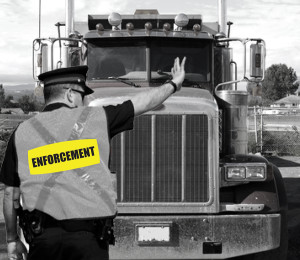 So, who can you call for information and where can you go for a DPF? I reached out to two of our advertisers, Joe Pashman, an Emissions Consultant with Ironman Parts in Corona, California (see their ad on page 40), and Jeff Hartman, Vice President of Sales & Marketing at Diesel Exhaust & Emissions in Santa Fe Springs, California (see their ad on page 29). Both of these guys were very helpful and both of these businesses seemed to be well-equipped to assist you in getting compliant with the CARB regulations.
So, who can you call for information and where can you go for a DPF? I reached out to two of our advertisers, Joe Pashman, an Emissions Consultant with Ironman Parts in Corona, California (see their ad on page 40), and Jeff Hartman, Vice President of Sales & Marketing at Diesel Exhaust & Emissions in Santa Fe Springs, California (see their ad on page 29). Both of these guys were very helpful and both of these businesses seemed to be well-equipped to assist you in getting compliant with the CARB regulations.
Over the years, Ironman has installed over 16,000 DPFs in California. They offer no-charge consulting and do a very hands-on personalized analysis of each individual scenario. They are authorized distributors and installers of several DPF manufacturers and have successfully completed several installs that were thought to be “impossible” applications. Ironman has fixed locations from Oakland to Southern California, but most of their installs are done by their mobile teams. They also offer DPF maintenance and cleaning, as well as smoke opacity testing at their fixed sites. For more information about their services or to find a location near you call (866) 306-4516 or visit them online (www.ironmanparts.com).
Diesel Exhaust & Emissions specializes in CARB-compliant DPF retrofits, and are proud to be partnered with all of the major DPF manufacturers. Their DPF retrofit costs are based on engine family, horsepower and temperature profile/duty cycle obtained by Data Logging your truck. The larger the horsepower, the larger the DPF (and the larger the cost)! On average, their customers are paying from $12,000 to $14,000 for a complete retrofit, including the data logging. In addition, they replace all of the exhaust parts from the turbo back and build a heavy duty custom mast to support the added weight of the DPF. There is a control box mounted on the dash that monitors the temperature and back pressure of the DPF. These aftermarket DPF systems do not plug in or interface with the truck’s CPU at all – they are stand-alone systems, and they will not affect the engine’s performance or fuel mileage.
The most important part of a successful retrofit is the pre-assessment. The folks at Diesel Exhaust & Emissions always check the engine for excessive smoke, and if the engine is running dirty, the filter will plug prematurely. These filters are very good at capturing the particulate matter in the exhaust and there will be absolutely no smoke coming from the stacks after the install. The majority of DPF problems out there can be traced back to engine issues that develop and drivers ignoring the warning lights – and improper regular cleaning and DPF maintenance.
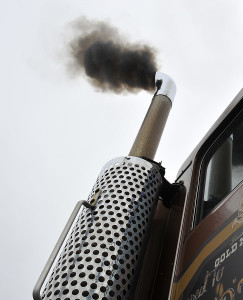 Jeramy Ostrander, founder and CEO of Diesel Exhaust & Emissions is passionate about customer service, honesty and integrity. “If an owner operator’s truck is running dirty, we will not put a DPF on it until the engine is fixed. CARB-compliant DPF retrofitting is ALL we do, and we know this is a big investment to our customers, so we want to do it right. Our mission is to provide the best service and products and make this CARB compliance mandate as painless as possible!” For more information about their products and services call (562) 944-0014 or visit them online (www.dieselexhaust.us).
Jeramy Ostrander, founder and CEO of Diesel Exhaust & Emissions is passionate about customer service, honesty and integrity. “If an owner operator’s truck is running dirty, we will not put a DPF on it until the engine is fixed. CARB-compliant DPF retrofitting is ALL we do, and we know this is a big investment to our customers, so we want to do it right. Our mission is to provide the best service and products and make this CARB compliance mandate as painless as possible!” For more information about their products and services call (562) 944-0014 or visit them online (www.dieselexhaust.us).
This is no April Fool’s joke – you must do your homework and make sure you get the proper information about your specific compliance needs, and then get a reputable installer, like the two I mentioned above, to fit your truck with the best possible solution. You simply cannot afford to fail one of these roadside tests. If you run in California, I hope you are not just now starting to consider a plan of action. But, if that is the case, just get on it now! For more information, visit the CARB website (www.arb.ca.gov) and get past all this compliance confusion today.
